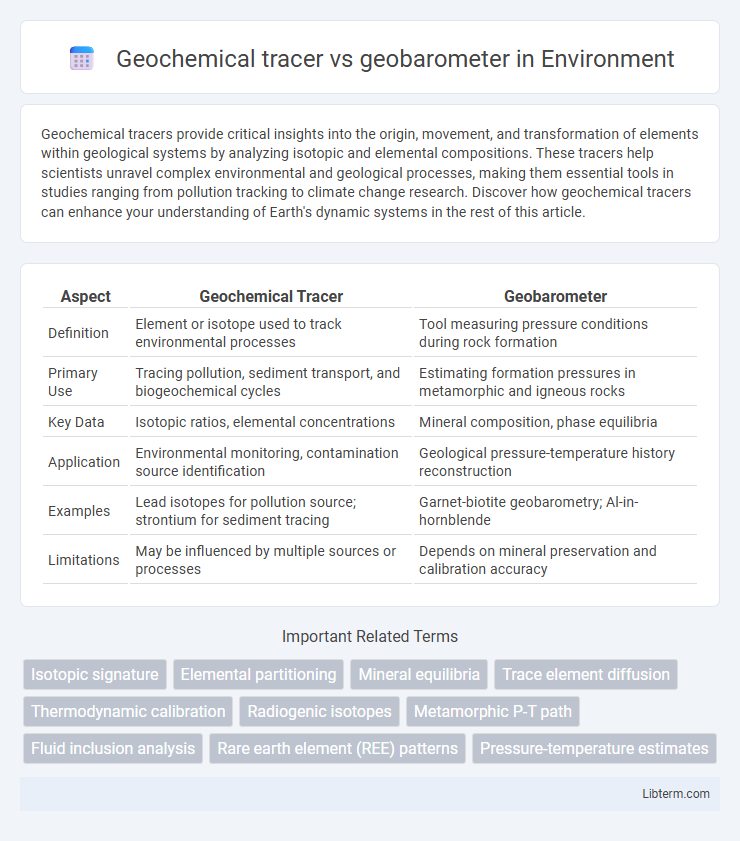Geochemical tracers provide critical insights into the origin, movement, and transformation of elements within geological systems by analyzing isotopic and elemental compositions. These tracers help scientists unravel complex environmental and geological processes, making them essential tools in studies ranging from pollution tracking to climate change research. Discover how geochemical tracers can enhance your understanding of Earth's dynamic systems in the rest of this article.
Table of Comparison
| Aspect | Geochemical Tracer | Geobarometer |
|---|---|---|
| Definition | Element or isotope used to track environmental processes | Tool measuring pressure conditions during rock formation |
| Primary Use | Tracing pollution, sediment transport, and biogeochemical cycles | Estimating formation pressures in metamorphic and igneous rocks |
| Key Data | Isotopic ratios, elemental concentrations | Mineral composition, phase equilibria |
| Application | Environmental monitoring, contamination source identification | Geological pressure-temperature history reconstruction |
| Examples | Lead isotopes for pollution source; strontium for sediment tracing | Garnet-biotite geobarometry; Al-in-hornblende |
| Limitations | May be influenced by multiple sources or processes | Depends on mineral preservation and calibration accuracy |
Introduction to Geochemical Tracers and Geobarometers
Geochemical tracers are elemental or isotopic signatures used to track processes such as fluid movement, rock alteration, and mantle source characteristics in geological systems. Geobarometers specifically measure pressure conditions during mineral formation by analyzing mineral chemistry, enabling precise reconstruction of metamorphic and magmatic environments. Both tools are essential for understanding the physicochemical history of rocks, with tracers highlighting mobility and sources, while geobarometers quantify pressure constraints.
Fundamental Principles of Geochemical Tracers
Geochemical tracers rely on the unique elemental and isotopic signatures of minerals or fluids to track geological processes, emphasizing the distribution and mobility of elements within different Earth reservoirs. Fundamental principles include the conservation of mass and distinct geochemical behavior of trace elements under varying temperature, pressure, and redox conditions. Unlike geobarometers, which specifically quantify pressure conditions during mineral formation, geochemical tracers provide broader information about source characteristics, transport pathways, and temporal evolution in geochemical systems.
Geobarometers: Definition and Mechanisms
Geobarometers are analytical tools used in geochemistry to determine the pressure conditions under which rocks and minerals form by analyzing their chemical compositions. These instruments rely on pressure-dependent reactions or phase equilibria within mineral assemblages that cause measurable changes in element partitioning or structural properties. Accurate pressure estimations from geobarometers provide critical constraints for reconstructing metamorphic processes and tectonic histories.
Key Differences Between Geochemical Tracers and Geobarometers
Geochemical tracers track elemental and isotopic signatures to identify source materials and processes, while geobarometers estimate pressure conditions during rock formation based on mineral equilibria. Tracers provide insights into petrogenesis, magma sources, and environmental changes, whereas geobarometers quantify depth and pressure in metamorphic and igneous contexts. The key difference lies in tracers' focus on compositional pathways versus geobarometers' emphasis on pressure-temperature reconstructions.
Common Applications in Geological Studies
Geochemical tracers are commonly applied to track the origin and movement of fluids or magmas in geological processes through isotopic and elemental signatures, aiding in the reconstruction of thermal histories and fluid pathways. Geobarometers are primarily used to estimate the pressure conditions during mineral formation by analyzing mineral compositions and their equilibria, providing crucial data on metamorphic and igneous rock formation depths. Both tools are essential for interpreting tectonic settings, metamorphic evolution, and magmatic differentiation in petrology and geodynamics research.
Analytical Techniques in Geochemical Tracer Investigation
Geochemical tracers utilize isotopic and elemental signatures analyzed through techniques such as mass spectrometry and X-ray fluorescence to track fluid sources, migration pathways, and reaction processes in geological systems. Geobarometers employ mineral chemistry and phase equilibria data, often measured by electron microprobe analysis or Raman spectroscopy, to estimate pressure conditions during rock formation. These analytical methods provide complementary insights; tracers reveal fluid origins and histories, while barometers constrain the pressure environment, enabling comprehensive interpretation of subsurface geochemical processes.
Calibration and Reliability of Geobarometers
Geobarometers require meticulous calibration using experimental petrology and natural rock assemblages to ensure precise pressure estimations in metamorphic studies. Geochemical tracers provide compositional data but lack direct pressure quantification, making calibrated geobarometers essential for reliable pressure reconstruction. The reliability of geobarometers depends on their calibration against well-constrained mineral equilibria and thermodynamic models that accurately reflect natural metamorphic conditions.
Case Studies: Geochemical Tracers vs Geobarometers in Petrology
Case studies in petrology demonstrate that geochemical tracers, such as isotopic compositions and trace element ratios, provide detailed insights into magma source characteristics and crustal contamination processes. Geobarometers, including mineral assemblage pressure estimations like garnet-biotite and clinopyroxene-aluminosilicate equilibria, offer quantitative constraints on the pressure conditions of rock formation. Integrating geochemical tracers with geobarometric data allows precise reconstruction of petrogenetic histories and tectonic settings in diverse geological environments.
Challenges and Limitations of Each Approach
Geochemical tracers face challenges in distinguishing overlapping sources and alterations during fluid-rock interactions, complicating precise origin identification. Geobarometers encounter limitations due to sensitivity to temperature fluctuations, pressure calibration uncertainties, and mineral compositional variability, which can yield ambiguous pressure estimates. Both approaches require careful interpretation of complex natural systems, often necessitating complementary techniques for robust geochemical and pressure reconstructions.
Future Trends in Geochemical and Geobarometric Research
Future trends in geochemical tracer and geobarometer research emphasize the integration of machine learning algorithms to enhance the precision of mineral and rock formation histories. Advances in in-situ micro-analytical techniques, such as LA-ICP-MS and SIMS, enable higher resolution isotope and elemental mapping, crucial for tracing geochemical processes and pressure conditions. Emerging studies focus on coupling geobarometric data with geochemical tracers to reconstruct dynamic tectonic environments and metamorphic evolution with unprecedented accuracy.
Geochemical tracer Infographic

 libterm.com
libterm.com